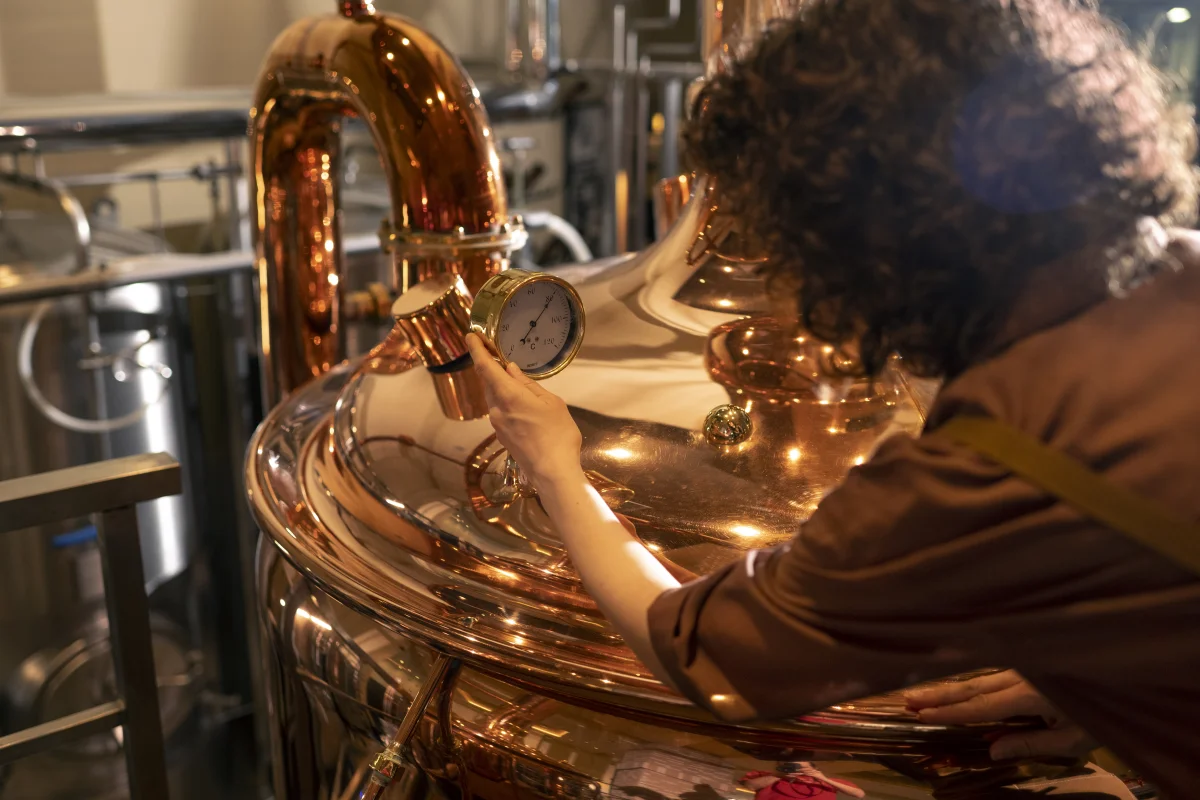The Copper Advantage: Chemistry in Action
When you walk into any traditional whisky, rum, or brandy distillery, the most striking visual is inevitably the constellation of copper vessels—burnished orange-pink, reflecting light in warm tones, often lovingly polished to a mirror shine. This isn't just aesthetic tradition; copper plays a crucial chemical role in crafting fine spirits.
The Sulfur Scrubber
The primary scientific benefit of copper lies in its ability to remove unwanted sulfur compounds. During fermentation, yeast produces various sulfur compounds—dimethyl sulfide, hydrogen sulfide, and others—that smell distinctly unpleasant. Think rotten eggs, cabbage, or struck matches. Left unchecked, these compounds would make spirits virtually undrinkable.
Copper acts as a catalyst in a reaction that binds these sulfur molecules, removing them from the vapor as it rises through the still. The technical term for this is "catalytic reaction" or "copper catalysis." As the hot alcoholic vapors contact the copper surface, sulfur compounds bind with the copper to form copper sulfate, which stays behind in the still rather than making its way into your drink.
This interaction is why you'll often see a blue-green patina forming inside stills and condensers. That blue-green substance? It's primarily copper sulfate—visual evidence of the metal actively "cleaning" your spirit.
Beyond Sulfur: The Full Spectrum
Copper's influence extends beyond sulfur removal. Research has shown that copper interacts with acids, aldehydes, and esters during distillation, affecting flavor development in complex ways. These reactions, collectively called "copper conversation" by some distillers, contribute to the smoothness and complexity that define traditional spirits.
This is why attempts to use stainless steel or other materials have largely failed to produce spirits with the same depth of character. Some modern distilleries use stainless steel for durability and easier cleaning, but nearly always include copper elements—either as interior components, mesh packing, or catalytic converters—to retain those crucial chemical interactions.
The Practical Tradeoff
Copper does have drawbacks. It's relatively soft, expensive, and requires regular maintenance. Copper stills wear down over time as that catalytic reaction gradually dissolves small amounts of the metal. This is why traditional distilleries often employ coppersmiths who specialize in repairing and maintaining these valuable tools.
A well-maintained copper still can last for decades, sometimes centuries. Many Scottish distilleries have stills that have been in operation for over 100 years, with sections periodically replaced as they thin from use. This maintenance cycle creates another fascinating aspect of spirit production: the "spirit fingerprint" of a distillery can subtly change after major still work, creating minute variations that only the most sensitive palates might detect.
Anatomy of a Pot Still: Form Follows Function
While all copper pot stills share the same basic operating principle—heating a fermented liquid to separate alcohol (which boils at a lower temperature than water) from unwanted components—their specific designs vary enormously. These variations aren't just decorative; they fundamentally influence the character of the distillate.
The Onion, The Lantern, and The Ball
The main body of the still, called the "pot" or "kettle," comes in various shapes, each with traditional names based on their appearance:
- Onion stills have a bulbous, rounded top that narrows toward the neck, creating reflux that produces a lighter spirit
- Lantern stills feature a more cylindrical pot with steep sides, allowing vapors to rise more directly with less reflux
- Ball stills have a spherical chamber that creates moderate reflux and a balanced spirit
The Critical Neck
Perhaps the most influential part of still design is the neck—the section above the pot that leads to the condenser. The height, width, and angle of this neck dramatically affect distillation:
-
Tall, narrow necks create more "reflux"—where heavier compounds condense and fall back down for redistillation. This produces lighter, more delicate spirits. Glenmorangie's famously tall stills (the tallest in Scotland) exemplify this approach, creating their characteristically light, floral whisky.
-
Short, wide necks allow more heavy compounds to pass through into the final spirit, resulting in oilier, more robust distillates. Distilleries like Lagavulin use this design to create their characteristically robust, flavor-packed whiskies.
The neck may also contain additional components like a "ball" (a spherical chamber) or a "purifier" (a small condenser that increases reflux), further fine-tuning the distillation profile.
The Lyne Arm: Pointing the Way
Extending from the top of the neck is the lyne arm—the pipe that carries alcoholic vapors toward the condenser. Its angle significantly impacts spirit character:
- Upward-angled lyne arms increase reflux, producing lighter spirits
- Downward-angled lyne arms reduce reflux, allowing more congeners through for heavier spirits
- Horizontal lyne arms create a middle-ground profile
Some distilleries, like Highland Park, even change the angle of their lyne arms seasonally to maintain consistency throughout the year, compensating for ambient temperature variations.
Condensers: From Worm Tubs to Shell-and-Tube
Once alcohol vapors travel through the lyne arm, they must be condensed back into liquid form. Two main types of condensers exist in traditional distilleries:
-
Worm tubs are the oldest design—coiled copper pipes submerged in cold water. These provide less copper contact during condensation and often contribute to a "meatier," more sulfurous spirit. Distilleries like Mortlach and Talisker still use worm tubs, prizing their contribution to a more robust spirit character.
-
Shell-and-tube condensers (also called "straight condensers") are more modern, efficient designs where vapor passes through copper tubes surrounded by cold water. These provide more copper contact and typically produce cleaner spirits with less sulfur character.
The choice between these condenser types significantly impacts the final product, with some distilleries maintaining traditional worm tubs specifically to preserve distinctive sulfur notes that define their house style.
The Master's Touch: Operating the Still
While the still's design establishes the base character, how it's operated adds layers of nuance. Master distillers manipulate several variables:
Heat Management
The rate of heating affects how rapidly alcohol and other compounds vaporize. Traditional direct-fired stills (heated by actual flames) create hot spots that can caramelize sugars and proteins on the still bottom, adding flavors that steam-jacketed stills (heated by steam circulating in an outer shell) cannot replicate.
The intensity and pattern of heating through the distillation run allows distillers to target specific flavor compounds that vaporize at different temperatures and times.
The Critical Cut Points
Perhaps the most crucial skill in distillation is determining the "cut points"—exactly when to start and stop collecting the distillate. A distillation run progresses through distinct phases:
-
Foreshots/Heads - The first compounds to vaporize, containing methanol and other volatile, often harsh compounds. These are always discarded.
-
Hearts - The desirable middle portion containing ethanol and pleasing flavor compounds. This becomes the final spirit.
-
Tails - The later portion containing fusel oils and heavier compounds. While some character-giving elements exist here, most tails are redirected to future distillations.
The precise moment of transition between these phases isn't fixed—it's determined by the distiller's judgment, often based on sampling the distillate as it flows from the still. Different distilleries cut earlier or later to achieve their desired profile, with earlier cuts producing cleaner spirits and later cuts capturing more robust flavors.
Distillery Fingerprints: The Whole Greater Than Its Parts
The combination of still design and operation creates what's often called a "distillery fingerprint"—a distinctive character that persists regardless of other variables. This is why spirit enthusiasts can often identify distilleries in blind tastings, recognizing their signature profiles.
When distilleries expand or replace stills, they go to extraordinary lengths to recreate exact duplicates of their existing equipment. Even dents are sometimes deliberately replicated, as distillers fear that any change might alter the carefully cultivated house style.
This obsessive attention to detail speaks to a fundamental truth: despite all our scientific understanding, there remains something slightly mysterious, almost alchemical, about copper pot distillation. Modern analytical techniques can identify thousands of compounds in spirits, yet nobody can perfectly predict how a new still design will perform until it's actually operating.
This blend of science and art, precision and intuition, makes traditional distillation endlessly fascinating. The copper pot still—a technology essentially unchanged since the Middle Ages—continues to produce spirits of remarkable complexity and character that modern, more "efficient" technologies can't quite match.
In an age of rapid technological advancement, there's something profoundly reassuring about watching master distillers work with these ancient tools, relying on senses honed through years of experience to capture the perfect spirit. The copper pot still isn't just a piece of equipment—it's a bridge between chemistry and craftsmanship, science and soul.

